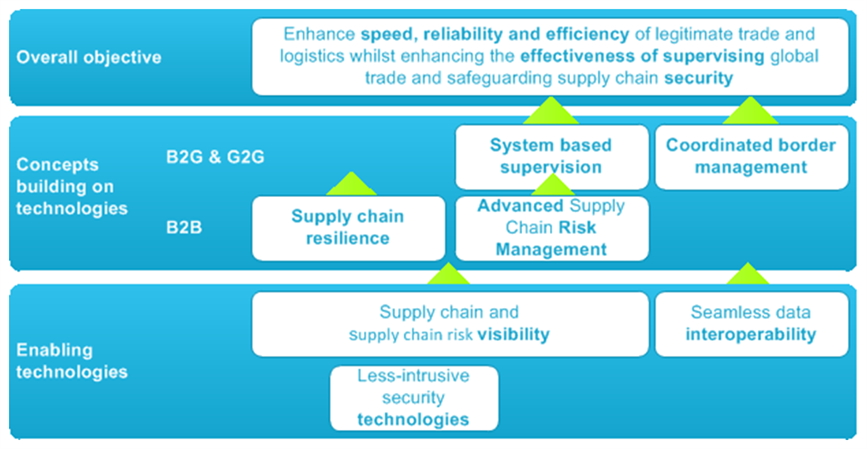One of the key discussion topics during the kickoff meeting was how CORE is to be managed in an effective way realising its challenging but rather abstract ambitions. Of course we have the Description of Work, describing the project aims, objectives and detailed activities. But we all know this document was also written to convince project evaluators during the proposal stage, thus including a lot of buzzwords, and leaving room for multiple interpretations of what is being achieved. So key question is what we exactly want to achieve and how the 22 work packages will contribute in realizing this aim.
We therefore agreed to develop an Innovation Agenda, a vision paper describing the ultimate objective of CORE and how this should be achieved. This vision is built upon the strong belief that enhanced supply chain security and optimization of supply chains can go hand in hand, by deploying 7 key innovative concepts, framed by two major transitions. Those transitions are needed because the evolution of the international trade system has come to an end game in further balancing economy and security after containerization, far-fetched supply chain fragmentation, and new societal threats such as terrorism and cyber security.
First, commercial supply chain actors need to reconsider the way they apply supply chain risk management, of course still driven by commercial interests. Now, they lack capabilities to seriously consider deploying collaborative chain control measures and are masters in transferring risks to outsourcing, downstream or upstream partners, whereas less powerful chain actors sometimes have no other option then just tolerate certain risks. Nobel prize winner Daniel Kahnemann explained this behavior in his best seller ‘Thinking Fast and Slow’. So we need to learn thinking slower and CORE is going to help us. Previous project, such as CASSANDRA have shown that this can result in highly positive business cases.
A large UK-based FMCG importer was confronted by huge discrepancies between the Packing List generated during container stuffing in China and the real content stripping the containers in the Port of Felixstowe. Boxes were filled with air to avoid a routing via a consolidation centre, resulting in unnecessary high transportation costs, underutilization of the transport system capacities and avoidable damage in warehousing. The business case of deploying a tallyman with a box scanner during container stuffing validating the packing list information was a no brainer, the inaccuracy dropped from 30% to less than 1%, with all corresponding savings. But that’s not all. The importer now considers to redesign its supply chain and apply destination based stuffing, allowing cross-dock operations in the Port of Felixstowe and seamlessly move the containers to the different UK-hinterland destinations.
But the example highlights another issue. The inaccurate packing list was also the basis for the entry summary declaration, the pre-departure security message implemented to help customs perform their risk assessment already before the goods enter the European territory. CASSANDRA has shown that the current ENS-procedure results in ineffective customs risk management. By showing in a customs dashboard that data in a declaration have undergone an effective validation process, it also helps customs in performing better risk management, re-using commercially driven control and validation processes . And that is what the second transition is all about, customs need to understand supply chain dynamics and how their supervision and enforcement intervenes with value chains. We call this chain based supervision.
The 7 concepts, see picture below, are not new. So what makes that there is momentum for these two major transitions to be accelerated? That is the CORE IT vision of seamless data interoperability. New semantic models make it possible to deploy a connectivity infrastructure where data capture and sharing in communities and value chains becomes possible for everyone, with minimum friction costs caused by different standards. A real breakthrough and crucial accelerator for the two key transitions. CORE has the possibility to radically change the system evolved from 400 years of international trade.
Isn’t that inspiring to be part of?
